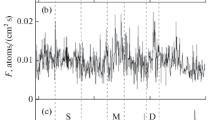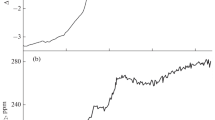Abstract
The paper presents reconstructions of the heliospheric modulation potential based on data on the content of the cosmogenic isotope 10Be in the ice layers of Antarctica (Dome Fuji). The calculations involve the use of two models that describe the relationship between the 10Be concentration in layers of ice C with the rate of formation of this isotope in the Earth’s atmosphere Q. The first model is described by a linear relationship between these quantities with a constant proportionality coefficient. In the second case, the proportionality coefficient between the concentration C and production rate Q changes over time in the considered model. The differences in the obtained reconstructions of the heliospheric modulation potential from Antarctica data from the reconstruction based on NGRIP data (Greenland) are analyzed. It was shown that the contradictions between the reconstructions can be removed if the dependence of the 10Be concentration in ice layers on the rate of its formation in the Earth’s atmosphere changes with time, which may be the result of climate change. Moreover, these dependences may be different for different regions.


Similar content being viewed by others
REFERENCES
Alley, R.B., Finkel, R.C., Nishiizumi, K., Anandakrishnan, A., Shuman, C.A., Mershon G.R., Zielinski, G.A., and Mayewski, P.A., Changes in continental and sea-salt atmospheric loadings in central Greenland during the most recent deglaciation: Model-based estimates, J. Glaciol., 1995, vol. 41, pp. 503–514.
Berggren, A.-M., Beer, J., Possnert, G., Aldahan, A., Kubik, P., Christl, M., Johnsen, S.J., Abreu, J., and Vinther, B.M., A 600-year annual 10Be record from the NGRIP ice core, Greenland, Geophys. Res. Lett., 2009, vol. 36, L11801.
Crowley, T.J. and Lowery, T.S., How warm was medieval warm period?, Ambio, 2000, vol. 29, pp. 51–54.
Etheridge, D.M., Steele, L.P., Langenfelds, R.L., Francey, R.J., Barnola, J.-M.I., and Morgan, V.I., Historical CO2 record derived from a spline fit (75 year cutoff) of the Law Dome DSS, DE08, and DE08-2 ice cores. http://cdiac. ornl.gov/ftp/trends/co2/lawdome.smoothed.yr75.
Horiuchi, K., Uchida, T., Sakamoto, Y., Ohta, A., Matsuzaki, H., Shibata, Y., and Motoyama, H., Ice core record of 10Be over the past millennium from Dome Fuji, Antarctica: A new proxy record of past solar activity and a powerful tool for stratigraphic dating, Quat. Geochronol., 2008, vol. 3, no. 3, pp. 255–261.
Kovaltsov, G.A., Mishev, A., and Usoskin, I.G., A new model of cosmogenic production of radiocarbon 14C in the atmosphere, Earth Planet. Sci. Lett., 2012, vol. 337, pp. 114–120.
Kudryavtsev, I.V., Reconstruction of heliospheric modulation potential based on data on the content of the cosmogenic isotope 10Be in greenland ice and the extremes of solar activity from the end of the 14th century, Geomagn. Aeron. (Engl. Transl.), 2020, vol. 60, no. 8, pp. 1028–1031.
Koudriavtsev, I.V., Dergachev, V.A., Nagovitsyn, Yu.A., Ogurtsov, M.G., and Jungner, H., On the influence of climatic factors on the ratio between the cosmogenic isotope 14C and total carbon in the atmosphere in the past, Geohronometria, 2014, vol. 41, no. 3, pp. 216–222.
Kudryavtsev, I.V., Dergachev, V.A., Kuleshova, A.I., Nagovitsyn, Yu.A., and Ogurtsov, M.G., Reconstruction of the heliospheric modulation potential and Wolf numbers based on the content of the 14C isotope in tree rings during the Maunder and Spörer minimums, Geomagn. Aeron. (Engl. Transl.), 2016, vol. 56, no. 8, pp. 998–1005.
Kuleshova, A.I., Dergachev, V.A., Kudryavtsev, I.V., Nagovitsyn, Yu.A., and Ogurtsov, M.G., Possible influence of climate factors on the reconstruction of the cosmogenic isotope 14C production rate in the Earth’s atmosphere and solar activity in past epochs, Geomagn. Aeron. (Engl. Transl.), 2015, vol. 55, no. 8, pp. 1071–1075.
Licht, A., Hulot, G., Gallet, Y., and Thebault, E., Ensembles of low degree archeomagnetic field models for the past three millennia, Phys. Earth Planet. Inter., 2013, vol. 224, pp. 38–67.
Moberg, A., Sonechkin, D.M., Holmgren, K., et al., Highly variable northern hemisphere temperatures reconstructed from low- and high-resolution proxy data, Nature, 2005, vol. 433, pp. 613–617.
Monnin, E., Indermühle, A., Dällenbach, A., Flückiger, J., Stauffer, B., Stocker, T.F., Raynaud, D., and Barnola, J.-M., Atmospheric CO2 concentrations over the last glacial termination, Science, 2001, vol. 291, pp. 112–114.
Monnin, E., Steig, E.J., Siegenthaler, U., et al., Evidence for substantial accumulation rate variability in Antarctica during the Holocene, through synchronization of CO2 in the Taylor Dome, Dome C and DML ice cores, Earth Planet. Sci. Lett., 2004, vol. 224, pp. 45–54.
Muscheler, R., Adolphi, F., and Nilsson, A., The revised sunspot record in comparison to cosmogenic radionuclide-based solar activity reconstructions, Sol. Phys., 2016, vol. 291, pp. 3025–3043.
Ogurtsov, M.G., Solar activity during the Maunder minimum: Comparison with the Dalton minimum, Astron. Lett., 2018, vol. 44, no. 4, pp. 278–288.
Ogurtsov, M.G., Kocharov, G.E., Lindholm, M., Eronen, M., and Nagovitsyn, Yu.A., Solar activity and regional climate, Radiocarbon, 2001, vol. 43, no. 2A, pp. 439–447.
Poluianov, S.V., Kovaltsov, G.A., Mishev, A.L., and Usoskin, I.G., Production of cosmogenic isotopes 7Be, 10Be, 14C, 22Na and 36Cl in the atmosphere: Altitudinal profiles of yield functions, J. Geophys. Res.: Atmos., 2016, vol. 121, no. 13, pp. 8125–8136.
Roth, R. and Joos, F., A reconstruction of radiocarbon production and total solar irradiance from the Holocene 14C and CO2 records: Implications of data and model uncertainties, Clim. Past, 2013, vol. 9, pp. 1879–1909.
SILSO, World Data Center, Sunspot Index and Long-term Solar Observations, Royal Observatory of Belgium. https://wwwbis.sidc.be/silso/.
Usoskin, I.G., Hulot, G., Gallet, Y., et al., Evidence for distinct modes of solar activity, Astron. Astrophys., 2014, vol. 562, p. L10.
Usoskin, I.G., Arlt, R., Asvestari, E., et al., The Maunder minimum (1645–1715) was indeed a grand minimum: A reassessment of multiple datasets, Astron. Astrophys., 2015, vol. 581, p. A95.
Zolotova, N.V. and Ponyavin, D.I., The maunder minimum is not as grant as it seemed to be, Astrophys. J., 2015, vol. 800, p. 42.
Author information
Authors and Affiliations
Corresponding author
Rights and permissions
About this article
Cite this article
Kudryavtsev, I.V. Possible Cause of Differences between Reconstructions of the Heliospheric Modulation Potential in the Past Based on Data on the 10Be Content in the Ice of the Antarctic and Greenland. Geomagn. Aeron. 61, 1216–1220 (2021). https://doi.org/10.1134/S0016793221080132
Received:
Revised:
Accepted:
Published:
Issue Date:
DOI: https://doi.org/10.1134/S0016793221080132




